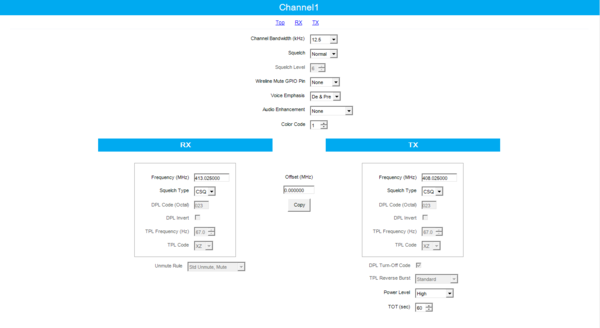Dynamic Mixed Mode
Dynamic Mixed Mode (DMM) is a feature that allows both analogue and digital radios users to share the same repeater. This is a single site configuration so IP Site Connect and Capacity Plus are not supported.
When a repeater is operating in DMM, it works as a standard repeater but will switch between analogue and digital depending on which radio is transmitting. The repeater cannot operate in digital and analogue mode at the same time and an analogue user would have to wait until a digital call is over before transmitting.
When in digital mode, the repeater will provide 2-slot operation as if it were a digital repeater. In analogue mode, it will function as a normal FM repeater. Digital radio users only need to switch between channels or their radios can be configured to scan both analogue and digital so they don't miss any calls.
This offers existing analogue users a smooth migration path from a purely analogue system to a purely digital one as the change can take place as their budget and operation requirements permit.
Description
When operating in Dynamic Mixed Mode (DMM), MOTOTRBO uses a pair of physical channels configured for 12.5 kHz channel bandwidth for digital operation and 12.5/20/25 kHz for analogue operation.
The repeater dynamically switches between analog and digital modes based on the call it receives from radios. If an analogue radio transmits, the repeater switches to analog mode to repeat the analogue call. However, the repeater only repeats analogue calls that are qualified by PL (DPL/TPL). If a digital radio transmits, then the repeater switches to digital mode to repeat the digital call if the call uses the right color code. While the repeater repeats one analog call at a time, it can repeat two digital calls at a time, one on each logical channel.
When a repeater repeats a new digital call that starts on one of the logical channels, the repeater does not qualify any analog call including an Emergency Call until the digital call (both the transmission and call hang time) is over and the corresponding channel hang time has expired. Upon the expiry of channel hang time, only then does the repeater start qualifying both analog and digital calls simultaneously. Similarly, if an analog call is being repeated, the repeater does not qualify any digital call including digital data and Emergency Calls on any of the two logical channels until the analogue call is over and the corresponding hang time has expired.
Dynamic Mixed Mode is a repeater only configuration and the main functions of this feature are:
- The system requires one pair of physical channels (one Tx frequency and one Rx frequency) for both analog and digital calls, one MOTOTRBO repeater, and one set of RF equipment (antenna, combiners, couplers, LNA, and others) to enable analog and digital radio users to communicate.
- This configuration allows the user to have a mix of legacy analog radios and the digital MOTOTRBO radios in a MOTOTRBO system.
- The repeater supports two independent time slots or logical channels within the 12.5 kHz physical channel bandwidth while repeating digital calls. However, the repeater supports one voice path (transmit and receive) on a 12.5/20/25 kHz channel while repeating analogue calls.
Analogue Consoles
Analogue console devices (e.g. the MC2500; Centro Plus etc.) are supported only when the repeater has not qualified an over the air digital call. If an analogue console device tries to key up the repeater when a digital call has been received over-the-air, the analogue call will be denied access. The repeater notifies the console via a channel busy tone generated over the speaker and Rx audio pins on the 4-wire repeater interface. Analogue consoles do not have priority over digital calls (voice or data) in DMM mode.
Unsupported Features
Dynamic Mixed Mode does not support the following configurations/features:
- IP Site Connect. In Dynamic Mixed Mode, the repeater can only repeat the digital calls over-the-air and cannot send the voice/data packets over the IP network. The status and the control of the repeater cannot be performed from a remote PC application like RDAC. However, it i possible to control the repeater locally using RDAC via the programming cable.
- Capacity Plus. In Dynamic Mixed Mode, trunking the logical channels of multiple MOTOTRBO repeaters as per Capacity Plus Single Site is not supported.
- FCC Type-I and Type-II monitoring. Since FCC Type-I and Type-II monitoring are not supported in single site analogue operation in any of the earlier MOTOTRBO releases, it is also not supported in Dynamic Mixed Mode single site operation.
- Transmit Interrupt. The Voice Interrupt, Emergency Voice Interrupt, Remote Voice Dekey, and Data Over Voice Interrupt features are presently not supported in Dynamic Mixed Mode systems.
- RDAC Over IP. RDAC over local USB and connections via GPIO are supported. RDAC over the network is not supported.
- Repeater Knockdown. In Dynamic Mixed Mode systems, this feature is not supported during an ongoing digital transmission.
- PTT on a 4-wire Interface. In Dynamic Mixed Mode systems, this feature is not supported during a digital repeat operation.
Configuration
A DMM channel in the repeater is exactly the same as any other channel type, except:
- Both Color Code and PL/DPL are listed.
- There is no selection for 20 or 25kHz operation - only 12,5kHz is supported.
To prevent interference to legacy analogue radios, it is reccomended to use PL (CTCSS) but not 67 and 103,5Hz as these old radios might mistake DMR transmissions as a valid tone. MOTOTRBO radios are not affected. Similarly, PL is needed on the repeater to prevent interference (birdies) from locking up the repeater making it inaccessible to digital users.
